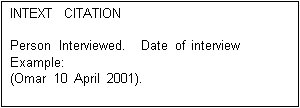 Purdue, Pete. Personal Interview. 1 Dec. 2000.
Purdue, Pete. Personal Interview. 1 Dec. 2000.
Interview that you conducted
 Purdue, Pete. Personal Interview. 1 Dec. 2000.
Purdue, Pete. Personal Interview. 1 Dec. 2000.
Interview that you conducted by phone
Purdue, Pete. Telephone Interview. 1 Dec. 2000.
Interview that you conducted by e-mail
Basic Form
Person Interviewed (e-mail address). Re: "Subject of Message." E-mail to _____________
(Your name)
(Your e-mail address). Message received date.
Example
Omar, Bill W. (bomar@aol.com
). Re: "Excellent Web Sites for Job Seekers." E-mail to Mary
Ellen Guffey (meguffey@westwords.com). 10 Apr. 2001.
(Your Works Cited entry)
_________________________________________________________________
_________________________________________________________________
Interview questions:
_1._________________________________________________________________________________
_2._________________________________________________________________________________
_3._________________________________________________________________________________
_4._________________________________________________________________________________
_5._________________________________________________________________________________
_6._________________________________________________________________________________
_7._________________________________________________________________________________
_8._________________________________________________________________________________
_9._________________________________________________________________________________
_10.________________________________________________________________________________
Interview answers:
.1._________________________________________________________________________________
_2._________________________________________________________________________________
_3._________________________________________________________________________________
_4._________________________________________________________________________________
_5._________________________________________________________________________________
_6._________________________________________________________________________________
_7._________________________________________________________________________________
_8._________________________________________________________________________________
_9._________________________________________________________________________________
_10._______________________________________________________________________________
Reference book used :
Ę
Author ____________________________________________________
Ę
Title ______________________________________________________
Ę
Publishing city _________________________________________
Ę
Publishing company _____________________________________________
Ę
Copyright date _____________________________________________
Multiple authors up to three
Sloan, Frank A., Emily M. Stout, , and Lan Liang. Atop an Underwood.
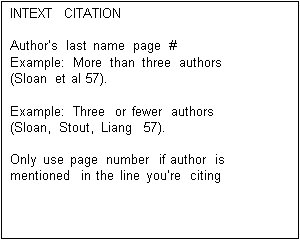 New York: Penguin, 2000.
New York: Penguin, 2000.
Multiple authors four or more
Sloan, Frank A., et al. Atop an Underwood. New York:
Penguin, 2000.
Single author
Kerouac, Jack. Atop an Underwood. New York:
Penguin, 2000.
 Article title ______________________________________________
Article title ______________________________________________
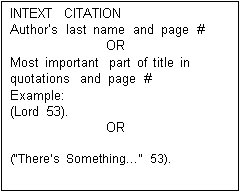 Title____________________________________________________
Title____________________________________________________
 Morgan, Fiona. "Banning the Bullies." Salon.com 15 Mar. 2001. 2 Apr.
Morgan, Fiona. "Banning the Bullies." Salon.com 15 Mar. 2001. 2 Apr.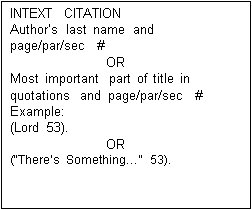
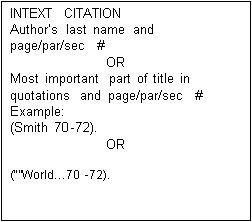 <http://www.infotrac.galegroup.com
>.
<http://www.infotrac.galegroup.com
>.
Article in a daily newspaper COMMA RULE#2
COMMA RULE#5
COMMA RULE #6
COMMA RULE#7
COMMA RULE #9
COMMA RULE #10
COMMA RULE #11
COMMA RULE #12
COMMA RUILE #13
SEMICOLON RULE #1
SEMICOLON RULE #2
SEMICOLON RULE #3
SPELLING RULE #1
SPELLING RULE #2
SPELLING RULE #3
SPELLING RULE #4
SPELLING RULE #5
WRONG WORD MISTAKES
APOS RULE #1
APOS RULE #2
APOS RULE #3
APOSTROPHEs APos1ŌĆöAPos2 APos3
Begin with the name of the author, if there is one, followed by the title of the article. Next give the name of the newspaper, the date, and the page number (including the section letter). Use a plus sign (+) after the page number if the article does not appear on consecutive pages.
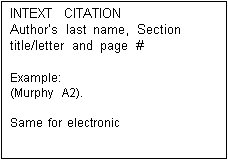 Murphy, Sean P. "Decisions on Status of Tribes Draw Fire." Boston
Murphy, Sean P. "Decisions on Status of Tribes Draw Fire." Boston
Globe 27 Mar. 2001: A2.
FROM AN ONLINE NEWSPAPER (Electronic)
Whillon, Phil. "Ready or Not." Los Angeles Times 2 Dec. 2001. 3 Dec.
2001 <http://www.latimes.com/news/la-foster-special.special
>.
(Your Works Cited entry)
_________________________________________________________________
_________________________________________________________________
Notes:
__________________________________________________________________________________
__________________________________________________________________________________
__________________________________________________________________________________
__________________________________________________________________________________
_________________________________________________________________________________
__________________________________________________________________________________
__________________________________________________________________________________
__________________________________________________________________________________
__________________________________________________________________________________
__________________________________________________________________________________
__________________________________________________________________________________
__________________________________________________________________________________
__________________________________________________________________________________
_________________________________________________________________________________
__________________________________________________________________________________
__________________________________________________________________________________
__________________________________________________________________________________
__________________________________________________________________________________
__________________________________________________________________________________
_________________________________________________________________________________
__________________________________________________________________________________
__________________________________________________________________________________
__________________________________________________________________________________
__________________________________________________________________________________
__________________________________________________________________________________
__________________________________________________________________________________
__________________________________________________________________________________
__________________________________________________________________________________
_________________________________________________________________________________
__________________________________________________________________________________
__________________________________________________________________________________
__________________________________________________________________________________
_________________________________________________________________________________
Pamphlet
Ę 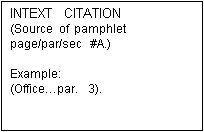 Source of pamphlet ____________________________________________
Source of pamphlet ____________________________________________
Ę
Title ________________________________________________________________
Ę
Place of publication: __________________________________________________
Ę
Publisher ___________________________________________________________
Ę
Copyright date. ______________________________________________________
Source of pamphlet. Title. Place of publication: Publisher, Copyright date.
Office of the Dean of Students. Resources for Success: Learning Disabilities and Attention Deficit
Disorders. West Lafayette, IN: Purdue University, 2000.
(Your Works Cited entry)
_________________________________________________________________
_________________________________________________________________
__________________________________________________________________________________
__________________________________________________________________________________
__________________________________________________________________________________
_________________________________________________________________________________
__________________________________________________________________________________
__________________________________________________________________________________
__________________________________________________________________________________
__________________________________________________________________________________
__________________________________________________________________________________
_________________________________________________________________________________
__________________________________________________________________________________
__________________________________________________________________________________
__________________________________________________________________________________
__________________________________________________________________________________
__________________________________________________________________________________
__________________________________________________________________________________
__________________________________________________________________________________
__________________________________________________________________________________
_________________________________________________________________________________
__________________________________________________________________________________
__________________________________________________________________________________
__________________________________________________________________________________
__________________________________________________________________________________
__________________________________________________________________________________
__________________________________________________________________________________
_________________________________________________________________________________
__________________________________________________________________________________
__________________________________________________________________________________
__________________________________________________________________________________
__________________________________________________________________________________
__________________________________________________________________________________
_________________________________________________________________________________
__________________________________________________________________________________
__________________________________________________________________________________

Editing Checklist
EDITING CHECKLIST
PRONOUNS

SUBJECTIVE:
I, you, he, she, it
We, you, they
Who, whoever
 OBJECTIVE:
OBJECTIVE:
Me, you, him, her, it
Us, you, them
whom, whomever

POSSESSIVE:
My, mine, his, her,
hers, its, our, ours,
Your, yours their, theirs,

RELATIVE:
Who-used with people
Which- used with animals, things
That- used with animals, things
PRONOUN MISTAKES
PRONOUN MISTAKES
Ę
PRONOUN REFERENCE = To what noun is the pronoun referring.
Ę
Ex. Tom went with she. (Nowhere in your writing have you told me who she is.)
Ę
PROUNOUN USAGE = You have used the wrong pronoun.
Ę
Ex. Tom went to the game with Sue and I. (Wrong pronoun is used.)
NOUNS
Ę
Persons, places, things, ideas
Ę
Two kinds of nouns
o
Proper ŌĆō Will begin with capital letter
¦
Jason, America, Chevrolet, Buddhism
o
Common ŌĆō Will only begin with a capital letter when it begins a sentence
¦
Boy, Country, Car, philosophy
VERBS
Ę
Action Verbs: Tells what action someone or something is performing
Ę
The following sentences contain ACTION VERBS:
Ę
I smelled a gas leak.
Ę
I submitted my research paper.
Ę
The puppy raced around the tree.
Ę
Linking Verbs: Connects the subject with a word near or at the end of the sentence (Forms of ŌĆ£beŌĆØ are the most common linking verbs)
The following sentences contain LINKING VERBS:
Ę
I am tall.
Ę
I ran home, and the cat was in the garage.
Ę
The walnuts were bitter, but the ice cream was sweet.
Ę
Some verbs may be ACTION or LINKING. To determine whether a verb is ACTION or LINKING, put is, are, was, or am in place of the verb. If the substitute verb makes sense, the original verb is a LINKING VERB.
Ę
The sheets smelled fresh and clean.
o
The sheets are fresh and clean.
¦
Therefore, smelled is a linking verb.
Ę
The driver stayed alert.
o
The driver was alert.
¦
Therefore, stayed is a linking verb.
COMMA RULES
COMMA RULE #1
COMMA RULE #1
Ę
Put a comma between the city and state.
Ę
Ex. I live in Lyons, New York.
Ę
Put a comma between the city and state and after the state when state is in mid sentence.
Ę
Ex. I have lived in Lyons, New York, all my life.
COMMA RULE#2
Ę
Put a comma between the day and year in a date.
Ę
Ex. I was born on September 3, 1951.
Ę
Put a comma between the day and year and after the year if the date is in mid sentence.
Ę
I was born on September 3, 1951, in Lyons, New York.
COMMA RULE #3
COMMA RULE #3
Ę
Introductory phrases, which can begin with a preposition, are set off by a comma if they contain four or more words. To find where the comma goes after the phrase, read the sentence out loud to see where you pause.
Ę
Ex. To succeed in a male-dominated field, women engineers must work very hard. (4 + words)
Ę
Ex. To succeed women engineers must work hard. (only 2 words)
Ę
If they comma is placed correctly, the next word after the comma will be:
Ę
Noun, pronoun, or an introducer like a, an, the, this, these, there
PREPOSITIONS

A prepositional phrase is a phrase consisting of a preposition and one or more nouns or pronouns. The first word in the phrase is the preposition. The last noun or pronoun in the phrase is the object of preposition.
COMMA RULE #4
COMMA RULE #4
Ę
Complex sentences contain two clauses (group of words containing a subject and verb).
Ę
Dependent clause ŌĆō Subordinate conjunction + subject/verb but no sense
Ę
Ex. When I run (not a complete sentence)
Ę
Independent clause ŌĆō subject/verb and sense
Ę
Ex. I get tired. (complete sentence)
Ę
A comma is needed when the dependent clause comes first.
Ę
Ex. When I run, I get tired.
Ę
If they comma is placed correctly, the next word after the comma will be:
Ę
Noun, pronoun, or an introducer like a, an, the, this, these, there
SUBORDINATE CONJUNCTIONS
SUBORDINATE CONJUNCTIONS
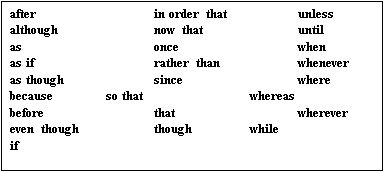
COMMA RULE#5
Ę
Use a comma when you form a compound sentence by linking two independent clauses with a coordinating conjunction.
Ę
Ex. The year was 2002, and everybody was back in school.
Ę
Both groups of words on each side of the AND is a complete sentence.
COORDINATING CONJUNCTIONS
COORDINATING CONJUNCTIONS
![]()
COMMA RULE #6
Ę
Use a comma to separate the person being spoken to from the rest of the sentence.
Ę
Ex. John, please shut the door. Please shut the door, John. Please, John, shut the door.
COMMA RULE#7
Ę
Use a comma to separate an interjection with the rest of the sentence.
Ę
Ex. No, I donŌĆÖt like you. Yes, I do like you. Well, what do you think?
COMMA RULE #8
Ę
Use a comma(s) to separate parenthetic expressions from the rest of the sentence.
Ę
Ex. Football, for example, is hard work. If you play, however, the hard work is worthwhile.
Ę
Ex. Nevertheless, football is a rough game. Soccer, on the other hand, is just as rough.
COMMA RULE #9
Ę
Use a comma to separate an appositive from the rest of the sentence, but only when it begins with a, an, the, this, these.
Ę
Ex. Maya Angelou, a great writer, grew up in Stamps, Arkansas.
COMMA RULE #10
Ę
Use commas to separate clauses which interrupt the flow of the sentence.
Ę
The used car I bought, which cost $2,000, broke down this morning.
COMMA RULE #11
Ę
Use a comma after an introductory phrases which begins with a verb (ed or ing ending) and precedes an independent clause.
Ę
Ex. Encouraged by the fan turnout, the soccer team rallied and defeated its archrival. (Ind. Cl.)
Ę
Ex. Taking it easy always makes good sense. (No Ind. Cl.)
COMMA RULE #12
Ę
Use a comma after a participle, a verb ending in ing or ed, which explains the word before it.
o
Ex. I went to the store, leaving the kids with their older sister.
COMMA RUILE #13
Ę
Use a comma to separate items in a series.
o
Ex. I went to the store and bought eggs, milk, and cereal.
SEMICOLON
SEMICOLON
Conjunctive Adverbs
Conjunctive Adverbs
![]()
Transitional Expressions
Transitional Expressions
![]()
SEMICOLON RULE #1
Ę
Use a semicolon before a conjunctive adverb that joins two independent clauses.
Ę
Ex. Lucas dropped Spanish IV; instead, he took French III.
SEMICOLON RULE #2
Ę
Use a semicolon before a transitional expression that joins two independent clauses.
Ę
Ex. Exercise is good for you; however, you must not over do it.
SEMICOLON RULE #3
Ę
Use a semicolon to link two closely related independent clauses.
Ę
Ex. Alaska is the largest state; Rhode Island is the smallest.
SPELLING RULES
SPELLING RULE #1
Ę
Words that end in sh, ch, s, x or z are made plural by adding es.
Ę
Ex. bushes churches glasses foxes quizes
SPELLING RULE #2
Ę
Words that end in y preceded by a vowel are made plural by adding s.
Ę
Ex. key = keys
SPELLING RULE #3
Ę
Words that end in y preceded by a consonant are made plural by dropping the y and adding ies.
Ę
Ex. baby = babies
SPELLING RULE #4
Ę
One-syllable words that end in a consonant double the final consonant before adding ed or ing.
Ę
Ex. grab = grabbed
SPELLING RULE #5
Ę
One-syllable words that end in e, drop the e before adding ing.
Ę
Ex. bake = baking
HOMONYMS
HOMONYMS

There = A Place/Is, are, was, were follows it Their = Ownership TheyŌĆÖre = They are
Its = Ownership ItŌĆÖs = It is Your = Ownership YouŌĆÖre = You are
Are = a verb Our = Ownership Hour = time
Homonyms are words that sound the same but are spelled differently and have different meanings.
WRONG WORD MISTAKES
Ę
When you make a homonym mistake in your writing, it will be labeled (WW) in the margin of your paper.
NUMBERING
Ę
Any number less than ONE HUNDRED should be written out (nine-nine NOT 99)
FRAGMENTS
FRAGMENTS
Ę
A sentence must contain a subject and a verb and make sense. If any of the three parts is missing, it is a fragment.
Ę
Ex. Because I like to. (Fragment-There is no sense.)
Ę
Ex. I like to go. (Good sentence)
RUN ONS
Ę
Two complete sentences joined together when they shouldnŌĆÖt be
APOSTROPHE
APOSTROPHE
APOS RULE #1
Ę
Use an apostrophe in a contraction to show that letters have been left out.
Ę
Ex. Can not = CanŌĆÖt Would have = WouldŌĆÖve
APOS RULE #2
Ę
Use an apostrophe to show ownership.
Ę
Ex. JimŌĆÖs coat is hang on the hook.
Ę
Ex. The girlsŌĆÖ team is looking good.
APOS RULE #3
Ę
Use an apostrophe to form plurals of letters, numbers, and symbols.
Ę
Ex. jŌĆÖs, kŌĆÖs 8ŌĆÖs, 9ŌĆÖs, 1980ŌĆÖs +ŌĆÖs, -ŌĆśs
SUBJECT VERB AGREEMENT
SUBJECT VERB AGREEMENT
Ę
Subjects and verbs must agree in number (singular and plural) and person (first, second, or third).
Ę
Ex. Hydrogen peroxide is an unstable compound.
Ę
Ex. The characters are not well developed in most of the story.
Ę
Notice that if the subject ends in (s), the verb doesnŌĆÖt, and if the subject doesnŌĆÖt end in (s), the verb does.
Ę
With words like some, all, any, more, most and none, it gets tricky.
Ę
Ex. Some of this trouble is to be expected. Some refers to trouble; therefore, the singular verb is, is used.
Ę
Ex. Some of the spectators are getting restless. Some refers to spectators; thus, the plural verb are, is used.
PARALLEL STRUCTURE
PARALLEL STRUCTURE
Ę
The same sentence structure should be used to express equivalent ideas.
Ę
Ex. I came, I saw, I conquer. (The first two verbs were in past tense, the third in present. Keep all parallel.
Ę
Ex. I look forward to hearing from you and to have an opportunity to tell you more about myself.
(The verb in the first part of the sentence is in (ing) form, the second verb is not. Keep all parallel.
CORRECTION SYMBOLS
CORRECTION SYMBOLS
COMMA RULES = Cr1ŌĆöCr2ŌĆöCr3ŌĆöCr4ŌĆöCr5ŌĆöCr6ŌĆöCr7ŌĆöCr8ŌĆöCr9ŌĆöCr10
Cr11ŌĆöCr12ŌĆöCr13
SPELLING RULES = SP1ŌĆöSP2ŌĆöSP3ŌĆöSP4ŌĆöSP5
APOSTROPHEs APos1ŌĆöAPos2 APos3
NO APOSTROPOHE NEEDED=NAPOS
SEMICOLON RULES =SEM1ŌĆöSEM2ŌĆöSEM3
SUBJECT/VERB AGREEMENT =SVA
PRONOUN REFERENCE = PRO REF
WRITE NUMBER OUT= WNO
PRONOUN USAGE = PRO USAGE
WRONG WORD = WW
NEW PARAGRAPH = P
![]() PARALLEL STRUCTURE =
PARALLEL STRUCTURE =
FRAGMENT =FRAG
WORD ENDING= WE
CAPITAL NEEDED=C
NO CAPITAL NEEDED= NC
NO PUNCTUATION NEEDED= NP
MISSING WORD= MW
RUN ON = RO
END PUNCTUATION NEEDED = ED
QUOTATION MARKS NEEDED
1